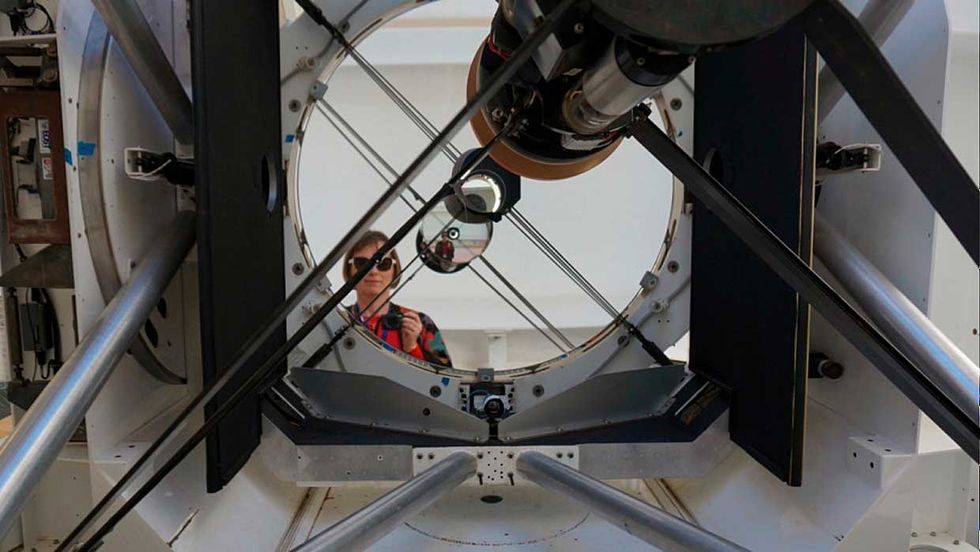Ever since humans started launching rockets into space, the amount of junk flying around Earth has been growing, to the point where debris has damaged satellites or forced the space station to shift its orbit. Now researchers in Australia want to use lasers to track the wayward particles, and even shove them out of the way before they cause problems.
“If we leave all this debris in space, eventually they are going to collide with each other and there's going to be a snowballing effect where more debris is created,” says Celine D’Orgeville, a professor at Australian National University’s Research School of Astronomy and Astrophysics in Canberra. “And at some point it would be so much debris at certain altitudes that we won't be able to use those altitudes anymore for human endeavors.”
She’s talking about the Kessler syndrome, shown to dramatic—and exaggerated—effect in the 2013 movie Gravity. Though it’s unlikely to produce a dramatic cascade of orbital crashes that shreds the International Space Station and leaves Sandra Bullock wearing a spacesuit in a lake, the space junk can cause problems. NASA says there are more than half a million pieces of debris, from disused satellites to flecks of paint, speeding around the earth at up to 17,500 mph.
D’Orgeville and her colleagues propose applying adaptive optics, a technique widely used in astronomy, to the problem of tracking the smaller pieces of debris, between 1 and 10 cm in size, which can be hard to see. Adaptive optics lets astronomers overcome the atmospheric turbulence caused by changes in pressure and temperature that makes the stars twinkle.
To do that, astronomers create a laser guide star by firing a yellow laser beam through a telescope. The beam strikes a layer of sodium particles high in the atmosphere, above the turbulence, and bounces back. Photodetectors measure distortions in the reflected beam to calculate the amount of turbulence, then instruct a series of actuators on a deformable mirror to push and pull on different parts of the mirror to compensate for the distortion. That causes a dramatic improvement in focus.

Using the system, D’Orgeville and her colleagues can fire a series of infrared laser pulses at the orbiting flotsam to measure where they are and where they’re headed. Without adaptive optics, they wouldn’t be able to focus the infrared laser well enough to find small objects. Knowing the path of the debris, they can warn, say, a communications satellite to alter its orbit slightly to avoid getting hit.
But the team wants to go further than that, and use yet another laser to actually push some of the debris out of the way. If they discover that two tiny pieces of space junk were headed for a crash—which might result in more, harder-to-track debris—they could fire a 20-kilowatt infrared laser at one of the pieces. The light pressure from the laser would be enough, after a few shots, to gently nudge the junk onto a different trajectory. “It's not going to destroy the debris or anything, but at least you can move it out of its way,” she says. “So the idea is to delay the Kessler effect.”
If they wanted to actually destroy the space junk, they could push it into a lower orbit, until it fell into the atmosphere and burned up like a meteor. But barring the development any sort of “tractor beam”-like pulling force, the laser would probably have to be based in space, where it could more easily push debris toward the planet.
The idea was developed at ANU’s Space Environment Research Centre, whose government funding recently dried up, so D’Orgeville is looking for a new funding source to help her demonstrate the proposal. All of the laser and adaptive optics equipment is available at the university’s Mt. Stromlo Observatory outside Canberra.
And she wants to reassure anyone who worries she may be shooting airplanes out of the sky or destroying expensive government satellites. There are regulations in place to avoid interfering with sky and orbital traffic, and the laser doesn’t pack that kind of punch. “We're nowhere near the power that would be required to damage anything,” she says. “We're just using pressure to change the orbit by a few centimeters at a time.”
Neil Savage is a freelance science and technology writer based in Lowell, Mass., and a frequent contributor to IEEE Spectrum. His topics of interest include photonics, physics, computing, materials science, and semiconductors. His most recent article, “Tiny Satellites Could Distribute Quantum Keys,” describes an experiment in which cryptographic keys were distributed from satellites released from the International Space Station. He serves on the steering committee of New England Science Writers.



